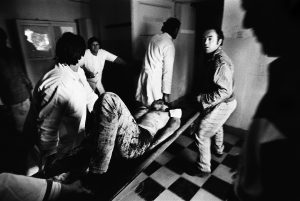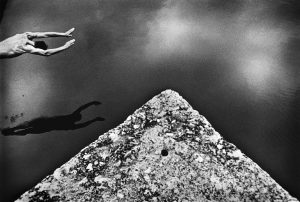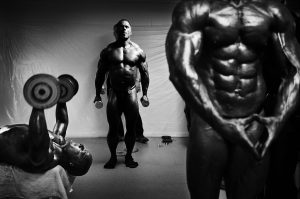There are just few photographers whose work is diversified in genres. Joachim Ladefoged, a member of the international photo agency VII, proves that good photographer can not be denoted just with the one label. He smoothly walks from documentary to reportage and work for commercial clients. His book Albanians is one of the best photography books ever published. After 9/11 he has changed his approach and started with new visual. It was an honor for me to talk about his life and approach to photography.
What does documentary photography mean to you and why did you choose it?
It means something that I miss doing a lot, real documentary work in a way that I like to tell the stories is something that I do very very seldom nowadays, partly of my own volition, because I have a family that I care about and that I want to spend time with, but also because the money for that kind of work has shrunk.
In 1998 you won 3rd prize for singles in the World Press Photo contest category People in the News, as well as the 1st prize for stories in the same category. Did it change your life somehow? 1998 seems to be a breakthrough year in your carrier.
Yes, it meant everything for a young man like me, all of a sudden I had an open window to a whole new world. I had this huge approval from an important institution like WPP. I was the first Dane to win two prizes and the first one to win with a story, so I got a lot of attention back home. So after those awards I basically joined an international photo agency, I got a Danish publisher who wanted to print my book Albanians and I decided to quit my staff job at Politiken and to try my hand at working in the magazine freelance world. So yes, the awards were a kickstarter for a new life.


Your book Albanians is shot in black and white and covers civil war in Albania in 1997 and the war in Kosovo 1998-1999. You photographed it from the social perspective of civil citizens. Do you have a favorite picture from this period? Can you describe why it is your favourite one?
I have so many favorite images from that project that it is hard for me to choose one. But if I have to choose one, it must be the one of a man killed by a stray bullet. He is lying in a small room surrounded by crying women, his wife, mother and his older brother. I like it for the situation and the journalistic story, the light, the framing and the story that follows. It won me the 3rd place at WPP. But more importantly I went back to the family 6 months later and gave them the print with my name written on the back of it. 20 years later I was contacted by the daughter of the dead man, who found me on FB and she wanted to reach out to me and see if I could share more images from the day of her father´s funeral. I sent her more images and later I met with her in Albania. It was very touching and emotional for me to hear her story and how her mother had managed to raise 3 kids on her own with two jobs and no husband.


There are still terrible war conflicts in the world. Do you perceive photography as a tool to raise questions?
Yes I still do, but we are bombarded with images every day, and it is very very rarely that we see a single image or a story that really changes life for the people that are in it. But I still hope that it is possible.
I have heard an opinion, I think Jan Grarup told it in one interview, that every picture should be taken but from the ethical point of view it is important which one will be published. Do you agree?
Basically, I totally agree with that, but it really comes down to the situation. We, the photographers, have to make the right choice in each situation. Every time we are in a situation of life and death we have to think about if we are putting people in danger in the situation or after, or if we are ethically stepping over a line by shooting the images or by publishing the images.


Black and white photography narrows down the storytelling within the frame. Compared to that, color photography is different and you need to combine more elements. How do you decide whether to shoot in color or in black and white?
I love doing both, and I often just choose before I go shoot a story. Nowadays with the digital cameras it is so easy to change the project to BW from colors, especially if the colors or the subject become too much of a fashion show.
I see many faces in your work. You jump from documentary to reportage and to portrait sessions. In which genre of photography do you feel the most comfortable?
My heart belongs to reportage, but I really like photography in general, so I like “jumping” around. In my daily work I often end up doing portraits, because there is nothing interesting to document or shoot. So I prefer the freedom that lays in the portrait photography.
Your latest book After my time is a personal introspection into your childhood. After 9/11 you completely changed your approach. Do you still have the same feeling?
Yes I still don’t do wars or going to risky places, I decided when I had my first child that I was over with the hardcore stuff. It was a very difficult decision and I still miss being out there and doing the important and big stories. But when I look at many of my friends and colleagues who nowadays are suffering from PTSD I am glad that I took that step away from danger and stress.
What do you think the main issues of today’s social documentary photography are? Lack of financial sources or the amount of visual stimulation people are facing nowadays so the important key message is blurred?
For sure the lack of financial sources, if we had the money we would for sure be able to tell the stories in a way that would be clear for even the most blurred readers.
You are an emeritus member of a great photo agency VII, a collective of 29 storytellers. What is the atmosphere there like? Do you have close colleagues with whom you consult your work?
I am very happy to be a part of such a talented group of hard working storytellers, but as you mentioned I am an emeritus member now. Meaning that I don’t have to deal so much with the daily issues of running the agency and since I am a staff photographer again, I am not so much in contact with the photographers in VII that are busy all over the world but more with the people I am sitting next to at the paper every day.
You directed a short film Mirror about bodybuilders. This series has also been published as a book. It reminds me of aliens or robots coming out of darkness. Very suggestive I would say. How did you feel as a director? Was it a completely new experience for you?
Being a director was a totally new experience for me, but it was such a great and fun thing to do and I would have loved to do it more. But I am not very patient when it comes to the editing process and I had a hard time accepting the slowness of all the things that come after the filming. But I also found that filming is a teamwork and not a one man work and I really liked that, so the film is a product of a great teamwork.


What advantages or disadvantages do you see in film comparing to photography?
I decided to shoot my Mirror film in a slow motion, because I found the slow motion film gave me some of the advantages that still images have over normal speed such as time to see and comprehend what is going on and time to dwell on each image. Films can be very powerful, especially with sound that gives moving images an extra layer.
Are you working on a personal long-term project now? If so, could you please elaborate?
My personal long term project right now is something totally different from photography and that is being the best dad and football coach for my daughter. She is our youngest child and only 10 years old, (and in her father´s eyes a talented football player ;-)), so until she has decided to be a professional player or not I am there for her on the football field twice a week. On a more serious note, I am always thinking about new projects but until my kids are well on their way I am trying to be a good father and spend time with my family, so my personal ambitions have to come in second.
Do you still have some unfulfilled dreams in photography?
Yes I still dream of making a living from only shooting work or images that I personally find interesting or important. But I feel blessed that I have already have fulfilled many of my dreams and that I am still able to live from shooting images and stories every day.
Joachim Ladefoged (*1970) has worked as a professional photographer since 1991 and is a member of the international photo agency VII. Today he works regularly for editorial clients such as The New York Times Magazine, TIME, MARE, and The New Yorker. Over the years Joachim Ladefoged has received numerous awards for his work from institutions such as Visa D’Or, World Press Photo, POYi, Eissie, and Agfa, as well as Picture of the Year in Denmark. He has been named one of Photo District News’ 30 emerging photographers to watch and he has participated in the Joop Swart Master Class at World Press Photo. Next to his carrier as a photojournalist, he has worked for commercial clients such as NIKE, Siemens, Bang & Olufsen, Vestas wind power, TDC, Danske Bank, IBM, Pepsi, Johnnie Walker & Gatorade. In 2000 he published his first book ‘Albanians’ that pictures the turbulent life of the Albanians between 1997 and 1999. In February 2008 he published his latest monograph “Mirror” and in 2009 he directed the short film “Mirror” about bodybuilders. With VII he has contributed to three major book projects: ‘Tsunami’, ‘Forgotten War: Congo’ and ‘VII – questions without answers‘. Joachim Ladefoged has exhibited his work in several solo and group exhibitions all over the world and is represented in the collection of the Danish Royal Library. Joachim Ladefoged is credited with being one of the driving forces behind the new wave of Danish photojournalism.
All photographs © Joachim Ladefoged.





